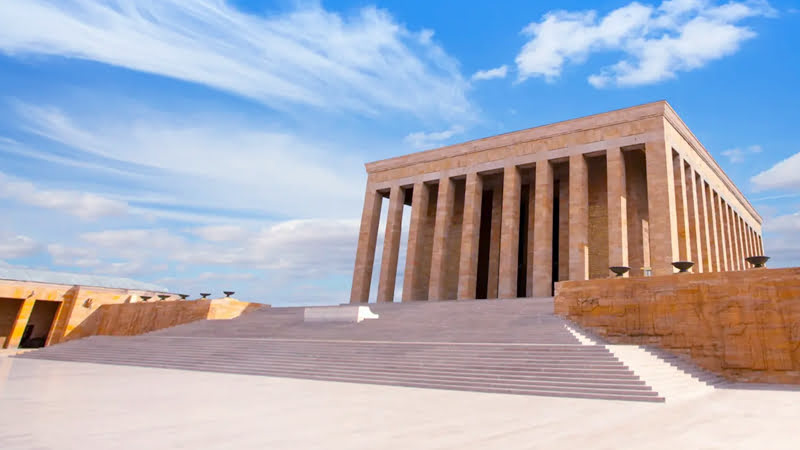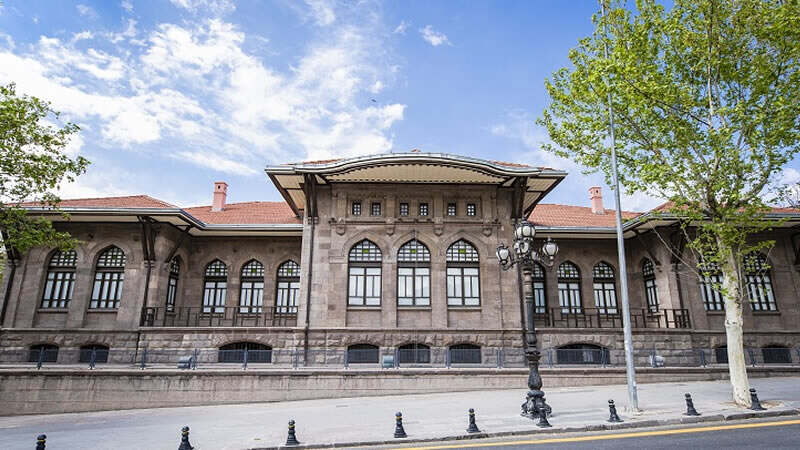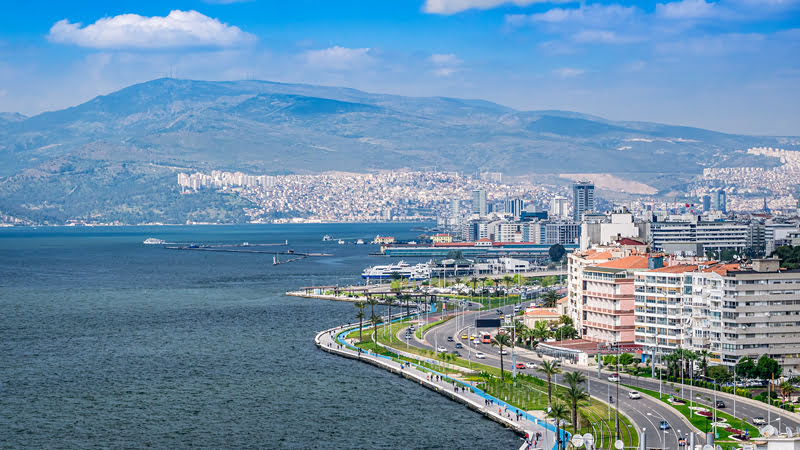Anitkabir - The Eternal Legacy of the Turkish Nation

Standing proudly at the heart of Ankara, Anitkabir is the final resting place of Mustafa Kemal Ataturk, the founder of the Republic of Türkiye. Each year, this important monument draws millions of visitors from within Türkiye and abroad. Anitkabir not only commemorates Ataturk’s life and principles but also symbolizes the significance of Türkiye's struggle for independence and the foundation of the Republic. It offers a profound historical experience to visitors of all ages and is a must-visit destination for anyone wishing to understand Türkiye's modernization journey.
Construction of Anitkabir began on October 9, 1944, and was completed in four main stages. The design was based on the project of Prof. Emin Onat and Assoc. Prof. Orhan Arda, who won a nationwide architectural competition in Türkiye. Throughout the construction, the project team worked diligently to create a structure that best reflects Ataturk's life and ideals. The construction of Anitkabir was made possible by the sacrifices of the Turkish people, voluntary donations, and state support. On November 10, 1953, Ataturk's remains were ceremoniously transferred from the Ethnography Museum to Anitkabir.
The stones used in the construction of Anitkabir were brought from various regions of Türkiye, symbolizing the participation of every part of the country in creating this monumental site. This aspect of Anitkabir is a testament to the Turkish people’s love and respect for Ataturk.
Located on Rasattepe, a strategically chosen hill in Ankara, Anitkabir covers a total area of 750,000 square meters. Its architecture combines elements inspired by Seljuk and Ottoman periods, blended with a touch of modernism. This unique architectural style transforms Anitkabir into not only a mausoleum but also a national symbol and work of art.
Anitkabir comprises four main sections: the Road of Lions, the Ceremonial Plaza, the Mausoleum, and the Anitkabir Museum.
Road of Lions: Leading to the Mausoleum, this 262-meter-long path is flanked by 24 lion statues symbolizing strength, courage, and guardianship, motifs often seen in Turkish art.
Ceremonial Plaza: At the end of the Road of Lions lies the expansive Ceremonial Plaza, one of the most impressive parts of Anitkabir, with a capacity for approximately 15,000 people. The plaza is decorated with 373 carpet and kilim designs made from black, red, yellow, and white travertine stones and serves as a key location for official ceremonies and commemorations dedicated to Ataturk.
Mausoleum: The Mausoleum is the most significant part of Anitkabir, housing Ataturk's tomb. The 40-ton tombstone bears the inscription, "Great Ataturk, the nation is grateful to you." The majestic yet modest design of the Mausoleum reflects Ataturk’s leadership qualities and the Turkish nation’s gratitude to him.
The museum within Anitkabir allows visitors to explore Ataturk’s life, his revolutions, and his works in depth. It displays his personal belongings, official documents, photos, and various memorabilia. Additionally, the museum offers panoramic depictions and dioramas depicting significant moments of the War of Independence and the foundation of the Republic of Türkiye.
Especially noteworthy are the reenactments of pivotal battles like the Sakarya and Great Offensive, providing visitors with a closer look at the struggles of war and the sacrifices of the Turkish nation. This museum serves as an essential stop for anyone interested in exploring Türkiye's modernization journey and Ataturk’s leadership.
War of Independence Section: This section showcases the significant moments of the War of Independence and Ataturk’s leadership on the battlefields. Panoramic depictions and dioramas of critical battles such as Sakarya and the Great Offensive transport visitors to the challenging atmosphere of that era, offering a deeper understanding of the difficulties of war and the sacrifices made by the Turkish nation.
Ataturk's Personal Belongings and Documents: This section provides a personal look into Ataturk's life through his clothing, personal items, correspondence, and important documents. The items displayed here give visitors a closer and more personal perspective on Ataturk’s life and the revolutionary changes he implemented.
Declaration of the Republic and Reforms: This section presents the critical events surrounding the declaration of the Republic of Türkiye and the reforms Ataturk carried out in detail, offering a deeper understanding of Türkiye's journey toward modernization.
Visiting Hours: Anitkabir is open daily. However, visiting hours vary between summer and winter, so checking the updated schedule beforehand is advised.
Guided Tours: For those interested in a more in-depth exploration, guided tours of Anitkabir and its museum provide detailed information on its history, architecture, and insights into Ataturk’s life.
Commemoration Ceremonies: One of the most powerful ways to visit Anitkabir is by attending the commemoration ceremonies held on November 10th. These ceremonies allow visitors to experience the intense atmosphere as thousands gather to pay tribute to Ataturk.
Anitkabir is centrally located in Ankara, in the Tandogan neighborhood of the Cankaya district, and is easily accessible from various parts of the city. For visitors using public transportation, the most convenient options are the metro and bus routes. Anitkabir is a 10-minute walk from the Tandogan Metro Station, and taxis are also available from the city center.
Anitkabir is not merely a mausoleum but also a symbol of the Turkish nation's struggle for independence and freedom. Reflecting Ataturk's reforms and the fundamental principles of the Republic of Türkiye, Anitkabir reminds visitors of the birth of a nation and the foundations of modern Türkiye. The monument symbolizes Ataturk’s love for and faith in his nation, while the Turkish people, in turn, express their loyalty and respect through this monumental site.
Each year, on November 10th, the significance of Anitkabir is emphasized through commemoration ceremonies. People of all ages visit Anitkabir that day, expressing their gratitude to Ataturk. These ceremonies serve as a critical opportunity to demonstrate the Turkish people's loyalty to Ataturk and his legacy. Additionally, international leaders and heads of state visiting Türkiye often pay their respects at Anitkabir, underscoring Ataturk's universal influence as a globally recognized leader.
Anitkabir is not only a reminder of the past but also a legacy passed on to future generations. Understanding the establishment of the Republic of Türkiye and Ataturk’s vision is a duty for every Turkish citizen. Therefore, students, young people, and children visiting Anitkabir gain a closer understanding of Ataturk’s ideals and Türkiye's modernization process. Anitkabir serves as an enlightening feature, strengthening the national consciousness and historical awareness of young generations.
As a proud testament of the Turkish nation, Anitkabir symbolizes Türkiye's place in the modern world. It is not just a tomb but a monument representing a nation's struggle for independence, Ataturk's leadership, and the determination of the Turkish people. Every stone and every detail in Anitkabir reflects Ataturk’s dedication to his nation and the Turkish people's gratitude toward him. Visiting Anitkabir is, in a sense, rediscovering Türkiye's path to modernization and understanding the vision of Ataturk and the foundations of the Republic of Türkiye.
Anitkabir, as an enduring symbol of the Turkish people’s respect, loyalty, and gratitude to Ataturk, has solidified its place in history. Welcoming millions of visitors each year, this site preserves the core values of the Republic of Türkiye and Ataturk's ideals. Anitkabir is not only a monument but also a symbol of Türkiye's struggle for independence, modernization process, and national unity. In this regard, everyone visiting Anitkabir witnesses the rebirth of a nation and gains the opportunity to understand once again the legacy left by Ataturk to the Turkish people.
The History and Construction of Anitkabir
Construction of Anitkabir began on October 9, 1944, and was completed in four main stages. The design was based on the project of Prof. Emin Onat and Assoc. Prof. Orhan Arda, who won a nationwide architectural competition in Türkiye. Throughout the construction, the project team worked diligently to create a structure that best reflects Ataturk's life and ideals. The construction of Anitkabir was made possible by the sacrifices of the Turkish people, voluntary donations, and state support. On November 10, 1953, Ataturk's remains were ceremoniously transferred from the Ethnography Museum to Anitkabir.
The stones used in the construction of Anitkabir were brought from various regions of Türkiye, symbolizing the participation of every part of the country in creating this monumental site. This aspect of Anitkabir is a testament to the Turkish people’s love and respect for Ataturk.
Architectural Features of Anitkabir
Located on Rasattepe, a strategically chosen hill in Ankara, Anitkabir covers a total area of 750,000 square meters. Its architecture combines elements inspired by Seljuk and Ottoman periods, blended with a touch of modernism. This unique architectural style transforms Anitkabir into not only a mausoleum but also a national symbol and work of art.
Anitkabir comprises four main sections: the Road of Lions, the Ceremonial Plaza, the Mausoleum, and the Anitkabir Museum.
Road of Lions: Leading to the Mausoleum, this 262-meter-long path is flanked by 24 lion statues symbolizing strength, courage, and guardianship, motifs often seen in Turkish art.
Ceremonial Plaza: At the end of the Road of Lions lies the expansive Ceremonial Plaza, one of the most impressive parts of Anitkabir, with a capacity for approximately 15,000 people. The plaza is decorated with 373 carpet and kilim designs made from black, red, yellow, and white travertine stones and serves as a key location for official ceremonies and commemorations dedicated to Ataturk.
Mausoleum: The Mausoleum is the most significant part of Anitkabir, housing Ataturk's tomb. The 40-ton tombstone bears the inscription, "Great Ataturk, the nation is grateful to you." The majestic yet modest design of the Mausoleum reflects Ataturk’s leadership qualities and the Turkish nation’s gratitude to him.
The Anitkabir Museum and Visitor Experience
The museum within Anitkabir allows visitors to explore Ataturk’s life, his revolutions, and his works in depth. It displays his personal belongings, official documents, photos, and various memorabilia. Additionally, the museum offers panoramic depictions and dioramas depicting significant moments of the War of Independence and the foundation of the Republic of Türkiye.
Especially noteworthy are the reenactments of pivotal battles like the Sakarya and Great Offensive, providing visitors with a closer look at the struggles of war and the sacrifices of the Turkish nation. This museum serves as an essential stop for anyone interested in exploring Türkiye's modernization journey and Ataturk’s leadership.
Museum Sections
War of Independence Section: This section showcases the significant moments of the War of Independence and Ataturk’s leadership on the battlefields. Panoramic depictions and dioramas of critical battles such as Sakarya and the Great Offensive transport visitors to the challenging atmosphere of that era, offering a deeper understanding of the difficulties of war and the sacrifices made by the Turkish nation.
Ataturk's Personal Belongings and Documents: This section provides a personal look into Ataturk's life through his clothing, personal items, correspondence, and important documents. The items displayed here give visitors a closer and more personal perspective on Ataturk’s life and the revolutionary changes he implemented.
Declaration of the Republic and Reforms: This section presents the critical events surrounding the declaration of the Republic of Türkiye and the reforms Ataturk carried out in detail, offering a deeper understanding of Türkiye's journey toward modernization.
Visitor Tips
Visiting Hours: Anitkabir is open daily. However, visiting hours vary between summer and winter, so checking the updated schedule beforehand is advised.
Guided Tours: For those interested in a more in-depth exploration, guided tours of Anitkabir and its museum provide detailed information on its history, architecture, and insights into Ataturk’s life.
Commemoration Ceremonies: One of the most powerful ways to visit Anitkabir is by attending the commemoration ceremonies held on November 10th. These ceremonies allow visitors to experience the intense atmosphere as thousands gather to pay tribute to Ataturk.
How to Reach Anitkabir
Anitkabir is centrally located in Ankara, in the Tandogan neighborhood of the Cankaya district, and is easily accessible from various parts of the city. For visitors using public transportation, the most convenient options are the metro and bus routes. Anitkabir is a 10-minute walk from the Tandogan Metro Station, and taxis are also available from the city center.
Symbolic Significance of Anitkabir
Anitkabir is not merely a mausoleum but also a symbol of the Turkish nation's struggle for independence and freedom. Reflecting Ataturk's reforms and the fundamental principles of the Republic of Türkiye, Anitkabir reminds visitors of the birth of a nation and the foundations of modern Türkiye. The monument symbolizes Ataturk’s love for and faith in his nation, while the Turkish people, in turn, express their loyalty and respect through this monumental site.
Each year, on November 10th, the significance of Anitkabir is emphasized through commemoration ceremonies. People of all ages visit Anitkabir that day, expressing their gratitude to Ataturk. These ceremonies serve as a critical opportunity to demonstrate the Turkish people's loyalty to Ataturk and his legacy. Additionally, international leaders and heads of state visiting Türkiye often pay their respects at Anitkabir, underscoring Ataturk's universal influence as a globally recognized leader.
Anitkabir and Future Generations
Anitkabir is not only a reminder of the past but also a legacy passed on to future generations. Understanding the establishment of the Republic of Türkiye and Ataturk’s vision is a duty for every Turkish citizen. Therefore, students, young people, and children visiting Anitkabir gain a closer understanding of Ataturk’s ideals and Türkiye's modernization process. Anitkabir serves as an enlightening feature, strengthening the national consciousness and historical awareness of young generations.
As a proud testament of the Turkish nation, Anitkabir symbolizes Türkiye's place in the modern world. It is not just a tomb but a monument representing a nation's struggle for independence, Ataturk's leadership, and the determination of the Turkish people. Every stone and every detail in Anitkabir reflects Ataturk’s dedication to his nation and the Turkish people's gratitude toward him. Visiting Anitkabir is, in a sense, rediscovering Türkiye's path to modernization and understanding the vision of Ataturk and the foundations of the Republic of Türkiye.
Anitkabir, as an enduring symbol of the Turkish people’s respect, loyalty, and gratitude to Ataturk, has solidified its place in history. Welcoming millions of visitors each year, this site preserves the core values of the Republic of Türkiye and Ataturk's ideals. Anitkabir is not only a monument but also a symbol of Türkiye's struggle for independence, modernization process, and national unity. In this regard, everyone visiting Anitkabir witnesses the rebirth of a nation and gains the opportunity to understand once again the legacy left by Ataturk to the Turkish people.



















































